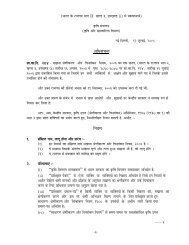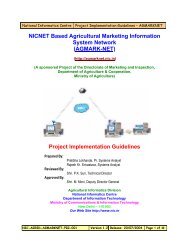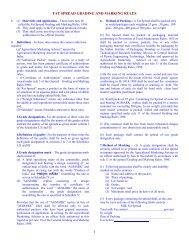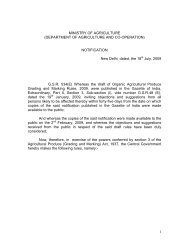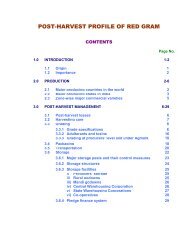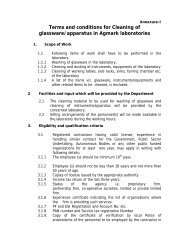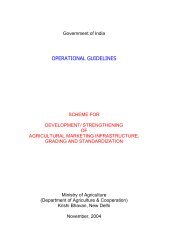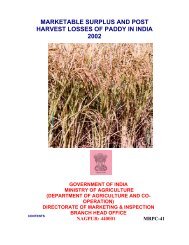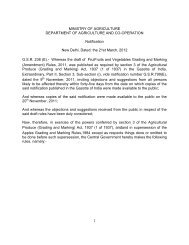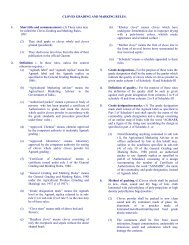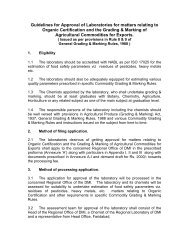Post - Harvest Management of Mushrooms with Special ... - Agmarknet
Post - Harvest Management of Mushrooms with Special ... - Agmarknet
Post - Harvest Management of Mushrooms with Special ... - Agmarknet
Create successful ePaper yourself
Turn your PDF publications into a flip-book with our unique Google optimized e-Paper software.
thermal sensitive produce are retained. This processing technique<br />
involves the cooling <strong>of</strong> mushroom much below the freezing point i.e. –<br />
40 o C where moisture present in mushroom is converted to tiny ice<br />
molecules which further directly sublime into vapour when subjected to<br />
vacuum <strong>with</strong> a slight rise in temp resulting a dried end product.<br />
Drying is the age old practice<br />
<strong>of</strong> preserving mushrooms at ambient<br />
temperatures. With the advancement <strong>of</strong><br />
technology, different kinds <strong>of</strong><br />
dehydration processes have been<br />
developed e.g. Sun drying, mechanical<br />
drying, air drying, micro-wave oven<br />
drying, etc. Among these the microwave<br />
Drying <strong>of</strong> mushroom<br />
oven drying is the best method. Vacuum<br />
drying process is followed in reduced pressure. In this process, the<br />
produce is subjected to a vacuum drier in which steam is present at<br />
about 1.0 to 1.5 bar. A vacuum pump is used to reduce pressure inside<br />
the product. The end product is obtained after completion <strong>of</strong> vacuum<br />
drying process.<br />
Pickling <strong>of</strong> mushroom is also a popular method <strong>of</strong> preserving. It is<br />
a more economically viable way during the surplus periods. By this<br />
process, mushrooms and different spices/condiments according to<br />
preference are fried separately. After that these are allowed to cool and<br />
filled in bottles/containers.<br />
In case <strong>of</strong> steeping preservation, mushrooms are preserved by<br />
steeping in a solution having 10-12% salt whereas the Radiation<br />
preservation <strong>of</strong> mushrooms is done by radiation <strong>with</strong> Gamma rays at the<br />
dose <strong>of</strong> 100-150 Krad to stop the post harvest growth and<br />
discolouration/deterioration <strong>of</strong> mushrooms.<br />
The major importing countries are U.S.A., Canada, Germany,<br />
Netherland, France, Switzerland, Japan and Malaysia. Earlier, major<br />
quantity <strong>of</strong> mushroom was exported in preserved/processed form but <strong>of</strong><br />
late the scenario is changing. Fresh mushrooms are preferred over<br />
preserved ones in EU and American countries. Till mid 90s, the entire<br />
production <strong>of</strong> mushrooms was consumed domestically. M/s. Ponds<br />
established a 100% EOU at Ooty which was exporting the packed<br />
mushrooms to USA. In 1994-95, some firms started using such<br />
techniques. High tech machinery <strong>with</strong> environmental control equipment<br />
were imported and mushrooms produced were canned and exported to<br />
Europe and USA. However, the entry <strong>of</strong> India in International market<br />
coincided <strong>with</strong> the crash <strong>of</strong> prices for mushroom in international markets<br />
because <strong>of</strong> competition from China. China was the leading exporter.<br />
However, the strong presence <strong>of</strong> China in market <strong>of</strong> U.S.A. was reduced<br />
due to imposition <strong>of</strong> anti-dumping duties by U.S.A.<br />
5




